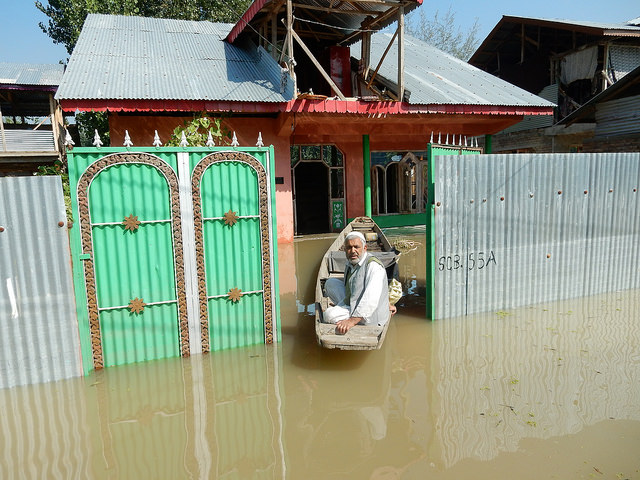An astounding surge in extreme weather events during the past few months in the Himalayan state of Jammu and Kashmir has not only affected economic and social activities in the region, but has also intrigued experts.
Apart from three official flood alerts since this March following recurring spells of incessant rain, around one dozen cloudbursts have struck various parts of Kashmir since June – killing ten people and damaging property worth millions of rupees.
The rain has also triggered a series of landslides – crucially along the Srinagar-Jammu national highway that connects Kashmir with the rest of India. The Srinagar-Leh highway – an alternate though very roundabout route – has also been affected.
Steep rise in landslides
Brigadier Ashish Kumar Das, chief engineer of India’s Border Roads Organisation (BRO) in Jammu and Kashmir, said that the Srinagar-Jammu national highway has recorded a fourfold increase in landslides this year. Landslides now occur at places where they did not occur before, he added.
“This has been happening during the past seven months or so. Earlier we used to witness landslides occurring at only 8-10 places along this national highway, but now there is an addition of another 10 places,” Das told thethirdpole.net.
“The roads were built based on old weather patterns. But now, the new extreme events are posing challenges which we find hard to deal with,” Das said. He added that the BRO has now hired experts to carry out a study and suggest measures for confronting the situation posed by these new challenges.
The state’s director of soil conservation Ravi Kumar Kesar said that landslides are now occurring at more places despite treatment of many landslide-prone spots. “Large-scale construction like creation of network of roads way up in the hills and other human activities are responsible for the increasing frequency of landslides,” Kesar told thethirdpole.net.
“Deforestation, unscientific road construction and terracing, encroachment on steep hill slopes have increased the frequency and intensity of landslides,” says a state disaster management policy report.
According to Kesar, the department does not have enough resources to treat the soil at numerous places. “We can’t do anything to prevent sliding of land at all these places given our paltry resources. The situation is especially grave in the hill districts of Poonch, Rajouri and Doda,” he said. The department gets an average Rs 800,000 ($12,352) for each district to prevent landslides. Some districts need over 50 times this amount.
Freaky weather fallout
Residents are surprised by the weather – and this is reflected in the local media. Srinagar-based newspaper Greater Kashmir headlined a July 28 editorial A Ticking Bomb. This was just four days after another editorial headlined Freak weather, ominous signs.
While the landslides and cloudbursts together killed around 18 people since March this year, the continuation of bad weather marked by a series of cloudbursts and incessant spells of rain have forced many people to either cancel elaborate wedding arrangements or rent party places indoors, instead of the usual marquees.
Weddings in Kashmir are characterised by elaborate traditional feasts, often cooked outdoors. This year is different. “I didn’t want to take a chance. So I spent Rs 60,000 over the accommodation at a government-owned facility for my wedding,” said Bilal Ahmad, who got married early August. Administrative staff at eight different government facilities in Srinagar said that they recorded over 40% increase in bookings this year.
Terrified tourists
Coming after the devastating September 2014 floods, the constant bad-weather news from Kashmir has led to many tourists cancelling their summer holidays in this otherwise popular destination. Hoteliers and shopkeepers in Srinagar told thethirdpole.net that there has been a 60% decline in tourist arrivals this year due to the constant flood scare, cloudbursts and storms.
Often called paradise on earth, Kashmir’s economy is heavily dependent on tourism, and tourist numbers had been picking up since 2010, when the valley appeared to be starting to recover from two decades of armed insurgency. According to figures maintained by Kashmir’s tourism directorate, a million domestic and foreign tourists visited Kashmir from January to July in 2014. The numbers in 2012 and 2013 were almost equal. But only half a million tourists visited the region by July this year. With schools and colleges across India having reopened after the summer holidays, the bulk of the tourist season is over.
The dwindling tourist numbers have dismayed over 100,000 people who are directly dependent on tourism for their livelihoods.
Siraj Ahmad, spokesman of Kashmir Economic Alliance, said that the repeated cloudbursts, landslides and heavy downpours since March this year – especially in the aftermath of last year’s devastating floods – led to a lot of media attention which portrayed Kashmir as nothing but a disaster centre.
More than 300 people perished in the September 2014 floods and thousands were marooned for over 15 days.
More cloudbursts
Shakil Romshoo, head of the Earth Sciences Department in Kashmir University, says that cloudbursts are not unknown in the region. “Kashmir has a history of cloudbursts, but what has been happening over the past weeks in this mountain region is certainly quite unusual. Though it deserves a detailed scientific study as to why the frequency of extreme weather events especially cloudbursts have increased, the increase in day temperatures across the Himalayan region can be a reason for the spurt in the number of cloudbursts.”

